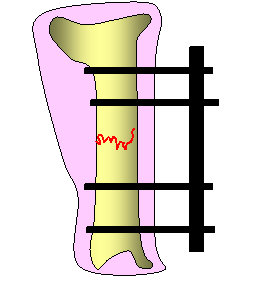Key Points
An external skeletal fixator is a device consisting of multiple pins and external rings or bars which hold a fractured bone in place during the healing process
External fixators are used primarily for complex fractures or ones in which external wounds are present
Special care of the fixator and pin tracts are necessary to prevent infection and unsuccessful healing of the fractrure

- An external skeletal fixator is a device the consists of pins that pass through the skin, underlying tissues and through the bone
- The pins are connected to a external bridging bar (see photo below)
Types of external fixators
- Standard fixator
- consists of pins that penetrate the bone and external bars the connect the pins together
- Circular fixator
- consists of very thin pins that penetrate the bone and skin on both sides and the pins are attached to metal circular plates or halos; each of the rings is attached to each other with long bolts
- this type of fixator is used for complex fractures and for angular limb deformity correction


Indications for use
- Fracture stabilization
- Correction of angular limb deformities
- Joint stabilization
- Support tendon repair (Achilles’ tendon tears)
Fixator care – this is critical to prevent infections
- It is critical that the fixator pins are bandaged
- The skin needs to be stabilized around the pin so that the soft tissues are not moving up and down the pin as the dog walks; movement of the soft tissues on the pin will lead to pin tract inflammation with subsequent infection
- The following steps are used to do pin site care
- If your pet is painful, administer a pain pill about 1 hour prior to the treatment
- Remove all bandage material and sponges from the pins and fixator
- Using clean Q-tips or sponges clean all crusts and discharge from the pins sites and the fixator bars and pins; an antiseptic such as Betadine (1:100 dilution) or Chlorhexidine (1:40 dilution) solution that has been diluted down (do not use soap); the antiseptic can be obtained from us, your veterinarian, or a drug store
- Apply triple antibiotic ointment such as Neosporin to each pin site
- Pack foam sponges (you can obtain this material from a hardware store or craft shop) around the pins. Make sure that there is enough foam between the fixator bar and the skin along the pin so that the skin is compressed down
- wrap each foam with material such as white tape, or vet wrap
- Any sharp points should also be wrapped with bandage material
- If the pin care has been properly done, the skin will rapidly heal around the pins and the discharge stops
- An infected pin tract is red, has discharge, is painful to touch, and will will not close down around the pin during the healing process.
- Process of potential unfortunate events: No pin care is done; Pin tract inflammation; Infection; Pin loosens; Fracture becomes unstable; Bone does not heal together
Fixator removal
- Usually a fixator is removed in a couple of stages so that the bone will be encouraged to strengthen with time
- Most fixators can be removed in three to four months
Potential complications
- Pin infections
- Pin loosening
- Pin migration
- Bent pins
- Acute profound hemorrhage from a pin site if the pin is rubbing against an artery; pin removal is needed


